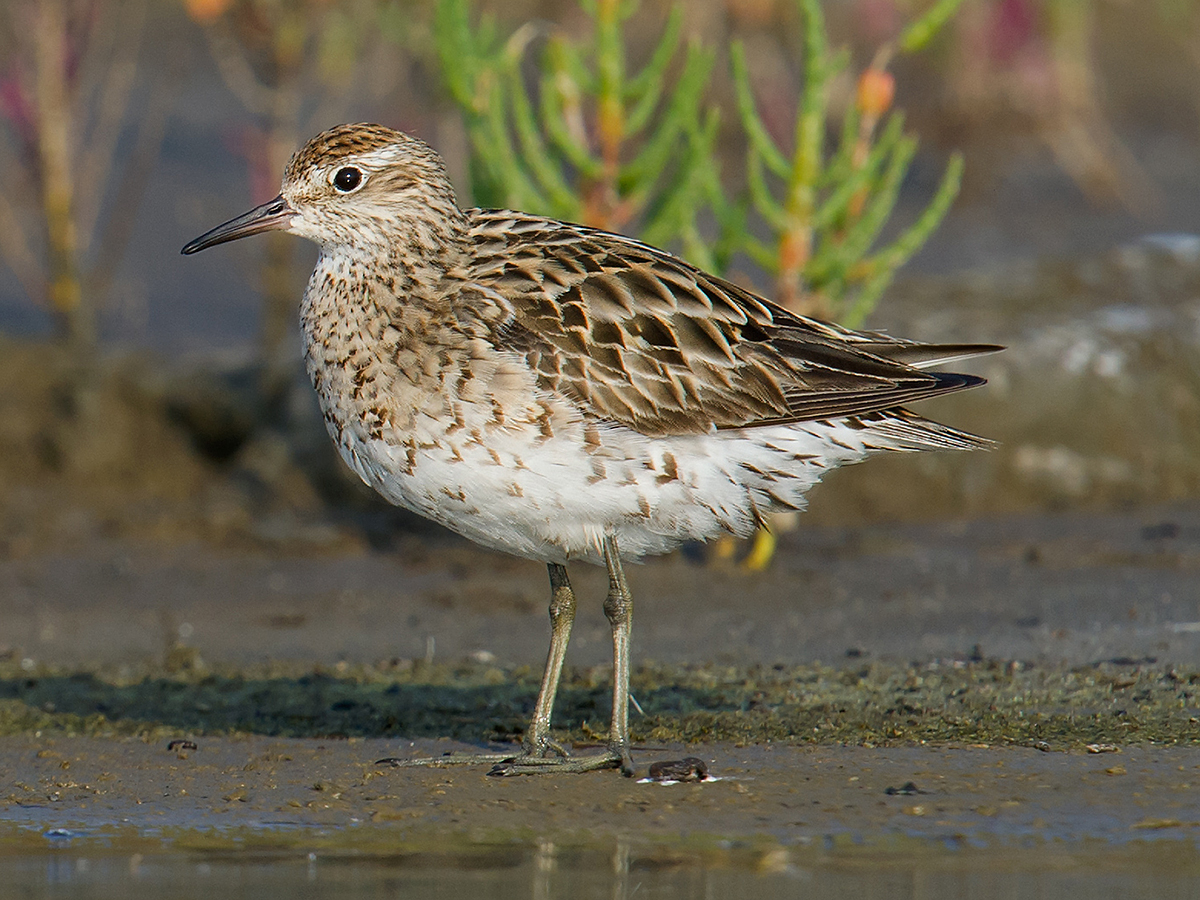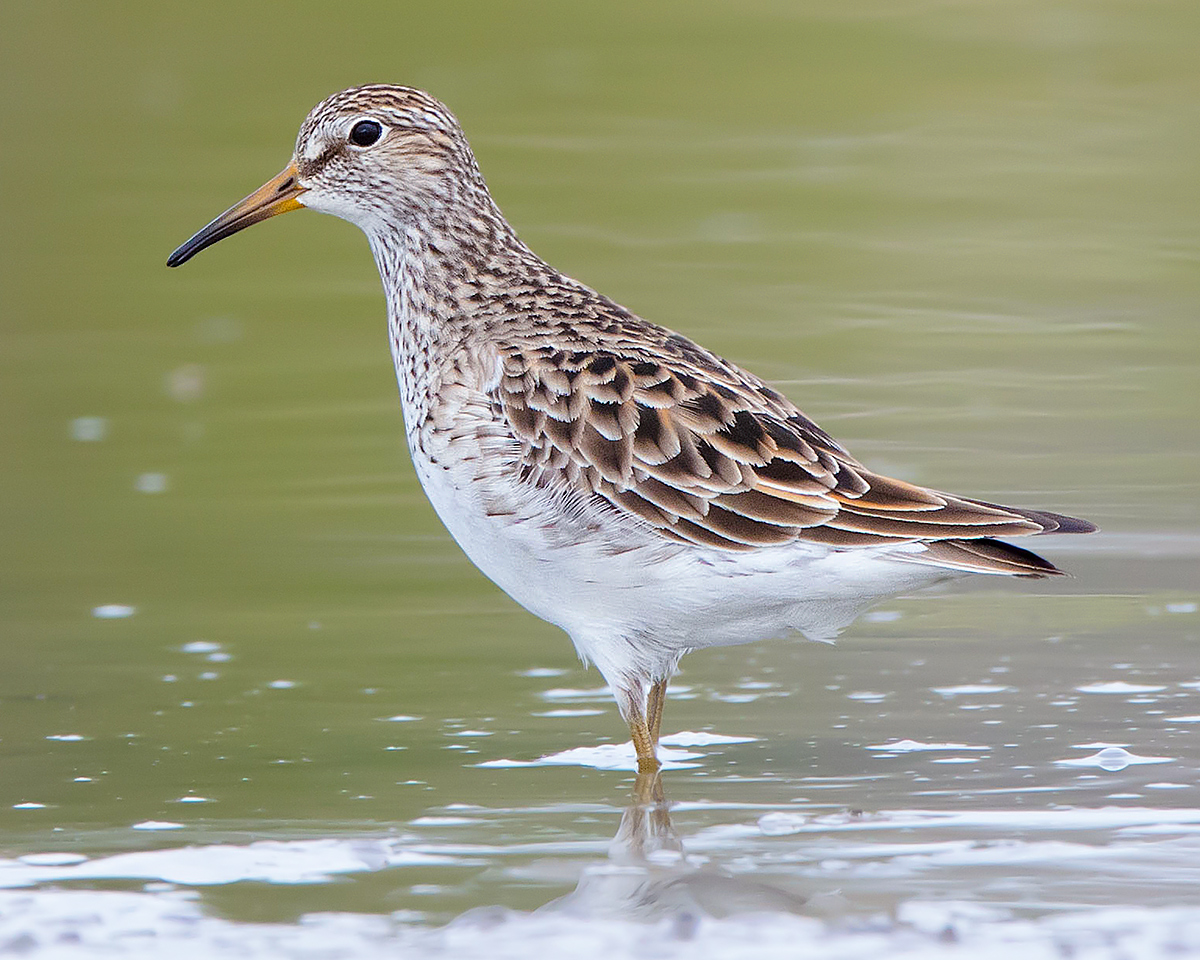
by Craig Brelsford
Founder, shanghaibirding.com
With breeding grounds high in the Siberian Arctic and a winter range extending as far south as New Zealand, Sharp-tailed Sandpiper Calidris acuminata is a champion long-distance migrant. In China migrates mainly along coast but regularly recorded inland. Common passage migrant Shanghai. HABITAT & BEHAVIOR Migrants often in marshy areas with vegetation as well as on intertidal mudflats. Juveniles strictly on coasts. ID & COMPARISON Breeding shows distinct rufous crown streaked black, a white eyebrow that often flares at the end and that is streaked black or brown, chestnut ear coverts, dark lores, and a thin white eye-ring. Upperparts black or brown with rufous and dull white fringing to feathers. Bold black spotting or streaking on neck and breast turning into chevrons on otherwise white lower breast, flanks, and undertail coverts. Breast has buff wash that is less clearly demarcated than Pectoral Sandpiper C. melanotos. Juveniles have blackish feather centers above, with rusty fringes (more buff on wing coverts), giving scaly appearance. White lines along mantle and scapulars usually prominent (but less so than Pectoral). Head pattern of Pectoral less contrasting; supercilium of Sharp-tailed cleaner (especially behind eye) and chestnut crown more prominent. Juvenile Sharp-tailed is bright and has prominent orange breast and breast streaking limited to a narrow band on upper breast; rest of underparts white. Winter adult a toned-down, greyish version of summer adult; distinct rufous cap present, but duller, with streaking usually restricted to sides of breast. In flight shows typical calidrid pattern of narrow white wing bar and white uppertail coverts divided by black central band from rump to tail. Streaking on white sides of rump make rump look darker than Pectoral. Juvenile Long-toed Stint C. subminuta appreciably smaller than Sharp-tailed. Male larger than female. BARE PARTS Bill short, slightly curved, black, with pale base to mandible; feet greenish-yellow. Legs shorter and posture usually more horizontal than Pectoral. VOICE Shrill, continuous twittering. Also soft, repeated plipp. — Craig Brelsford
THE CALIDRIDS OF CHINA
shanghaibirding.com covers every species in the genus Calidris in China. Click any link below:
Great Knot Calidris tenuirostris
Red Knot C. canutus
Ruff C. pugnax
Broad-billed Sandpiper C. falcinellus
Sharp-tailed Sandpiper C. acuminata
Curlew Sandpiper C. ferruginea
Temminck’s Stint C. temminckii
Long-toed Stint C. subminuta
Spoon-billed Sandpiper C. pygmaea
Red-necked Stint C. ruficollis
Sanderling C. alba
Dunlin C. alpina
Rock Sandpiper C. ptilocnemis
Baird’s Sandpiper C. bairdii
Little Stint C. minuta
Least Sandpiper C. minutilla
White-rumped Sandpiper C. fuscicollis
Buff-breasted Sandpiper C. subruficollis
Pectoral Sandpiper C. melanotos
Western Sandpiper C. mauri
ACKNOWLEDGEMENTS
Daniel Bengtsson served as chief ornithological consultant for my Photographic Field Guide to the Birds of China, from which the species description above is drawn.
BIBLIOGRAPHY
Alderfer, Jonathan, ed. (2006). National Geographic Complete Birds of North America. National Geographic Society, Washington, D.C.
Brazil, Mark (2009). Birds of East Asia. Princeton University Press, New Jersey.
Brazil, Mark (2018). Birds of Japan. Helm Field Guides, London.
eBird (2020). eBird: An online database of bird distribution and abundance [web application]. eBird, Cornell Lab of Ornithology, Ithaca, New York. Sharp-tailed Sandpiper (https://ebird.org/species/shtsan). Accessed: 26 Aug 2021.
MacKinnon, John & Karen Phillipps (2000). A Field Guide to the Birds of China. Oxford University Press.
Message, Stephen & Don Taylor (2005). Waders of Europe, Asia and North America. Helm Field Guides, London.
Svensson, Lars, Killian Mullarney, & Dan Zetterström (2009). Collins Bird Guide: The Most Complete Guide to the Birds of Britain and Europe. 2nd ed. HarperCollins, London.

